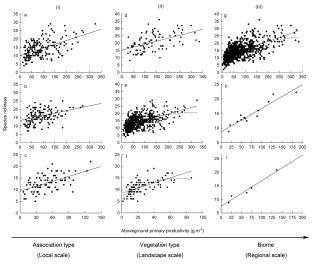Based on data from 854 field sites across the Inner Mongolia region of the Eurasian Steppe, the group led by Prof. Xingguo Han tested the form of the productivity-diversity relationship (PDR) at different organisational levels (association type, vegetation type, and biome) and multiple spatial scales (local, landscape, and regional). The results showed that a positive linear rather than hump-shaped form was ubiquitous across all organisational levels and spatial scales examined. On the regional scale, this monotonic PDR pattern corresponded closely with the gradient in mean annual precipitation and soil nitrogen. Increasing species' dissimilarity with productivity could also contribute to the positive linear form of PDR. The results also indicated that grazing decreased both primary productivity and species richness but, intriguingly, not the form of PDR. This study provides the first direct test of the PDR for the world's largest contiguous terrestrial biome – the Eurasian Steppe. The predominance of a positive linear relationship in this region defies the commonly held view that a unimodal form of PDR dominates terrestrial ecosystems, which is supported mainly by studies in Africa, Europe, and North America. It suggests that precipitation has a greater control on the PDR in the Eurasian Steppe than grasslands elsewhere. Also, the positive linear relationship is surprisingly robust to grazing. These results provide new insight into the PDR and have several implications for restoring degraded lands and understanding ecological consequences of climate change in the Eurasian Steppe (Journal of Applied Ecology, 2007). 
Figure . Relationships between productivity and species richness at different organizational levels and spatial scales. Ⅰ ) At the level of association type or the local scale, three association types are shown as examples: a , Leymus chinensis association; b , Stipa grandis association; c , Stipa krylovii association. ( Ⅱ ) At the level of vegetation type or the landscape scale: d , Meadow steppe; e , Typical steppe; f , Desert steppe. ( Ⅲ ) At the level of biome or the regional scale: g , By individual site; h , By association type; i , By vegetation type. The fitted lines represent statistically significant linear (solid line) and quadratic (dashed line) relationships between productivity and species richness.
